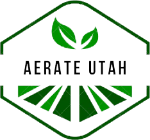Lawn Education

Benefits of Lawn Aeration
Lawn aeration, a process involving perforating the soil with small holes to allow air, water, and nutrients to penetrate the grassroots, offers several benefits for maintaining a healthy and vibrant lawn.
Improved Oxygen Circulation: Aeration facilitates better oxygen circulation within the soil, promoting the respiration process of the grass roots. Adequate oxygen levels are essential for root growth and overall plant health. By opening up the soil, aeration ensures that roots have access to the oxygen they need, leading to stronger and more resilient grass.
Enhanced Water Absorption: Compacted soil can hinder water absorption, leading to poor drainage and water runoff. Aeration helps alleviate soil compaction, allowing water to penetrate deeper into the root zone. Improved water absorption ensures that grass roots receive adequate moisture, promoting lush growth and reducing the risk of drought stress.
Nutrient Uptake and Fertilizer Efficiency: Aeration creates pathways for nutrients and fertilizers to reach the grassroots more effectively. Without proper aeration, nutrients may remain trapped near the soil surface or be washed away by rain or irrigation. By enhancing nutrient uptake, aeration promotes healthier grass growth, resulting in a thicker, greener lawn.

Fertilization + Overseed
Fertilization and overseeding are vital practices for maintaining a lush, healthy lawn, providing numerous benefits that contribute to the overall appearance and resilience of your turf.
Nutrient Enrichment and Soil Health: Fertilization replenishes essential nutrients in the soil, such as nitrogen, phosphorus, and potassium, which are crucial for optimal grass growth and development. These nutrients support root strength, disease resistance, and vibrant coloration. Additionally, fertilization promotes microbial activity in the soil, enhancing nutrient cycling and overall soil health.
Enhanced Grass Density and Coverage: Overseeding involves spreading grass seed over existing turf to fill in thin or bare areas, promoting denser grass coverage. This process helps to repair damage from foot traffic, pests, or environmental stressors, resulting in a thicker and more uniform lawn. Overseeding also introduces new grass varieties that may be more resistant to disease, drought, or other adverse conditions, further improving the resilience of the turf.
Weed and Pest Suppression: A healthy, well-fertilized lawn with dense grass coverage can naturally suppress weed growth by shading out weed seeds and preventing them from germinating. Additionally, overseeding helps to outcompete weeds by filling in bare spots where weeds would otherwise take hold. Moreover, a thick turf can deter pests by creating a less hospitable environment for insects and other lawn-damaging organisms.

Dethatching/Power Raking
Improved Air and Water Penetration: "Dethatching" and "Power Raking" are terms people use interchangeably. Thatch buildup can create a barrier that impedes the penetration of air, water, and nutrients into the soil. Power raking effectively removes this layer of thatch, allowing for better air circulation and water infiltration into the root zone. Improved soil aeration and hydration enhance root development and overall grass health, leading to stronger, more resilient turf.
Prevention of Disease and Pest Issues: Excessive thatch accumulation creates an ideal environment for fungal diseases, pests, and insect infestations. By dethatching the lawn, you reduce the habitat for these harmful organisms, minimizing the risk of disease outbreaks and pest damage. Additionally, power raking exposes the soil surface, making it less hospitable for pests and pathogens to thrive, thereby promoting a healthier lawn ecosystem.
Stimulated Grass Growth and Regeneration: Power raking stimulates grass growth and regeneration by removing the layer of thatch that can choke out new shoots and stifle root development. By eliminating the barrier to growth, dethatching encourages the emergence of new grass blades and promotes the spread of existing turf. This results in a thicker, more vigorous lawn with improved aesthetics and better tolerance to environmental stressors.
